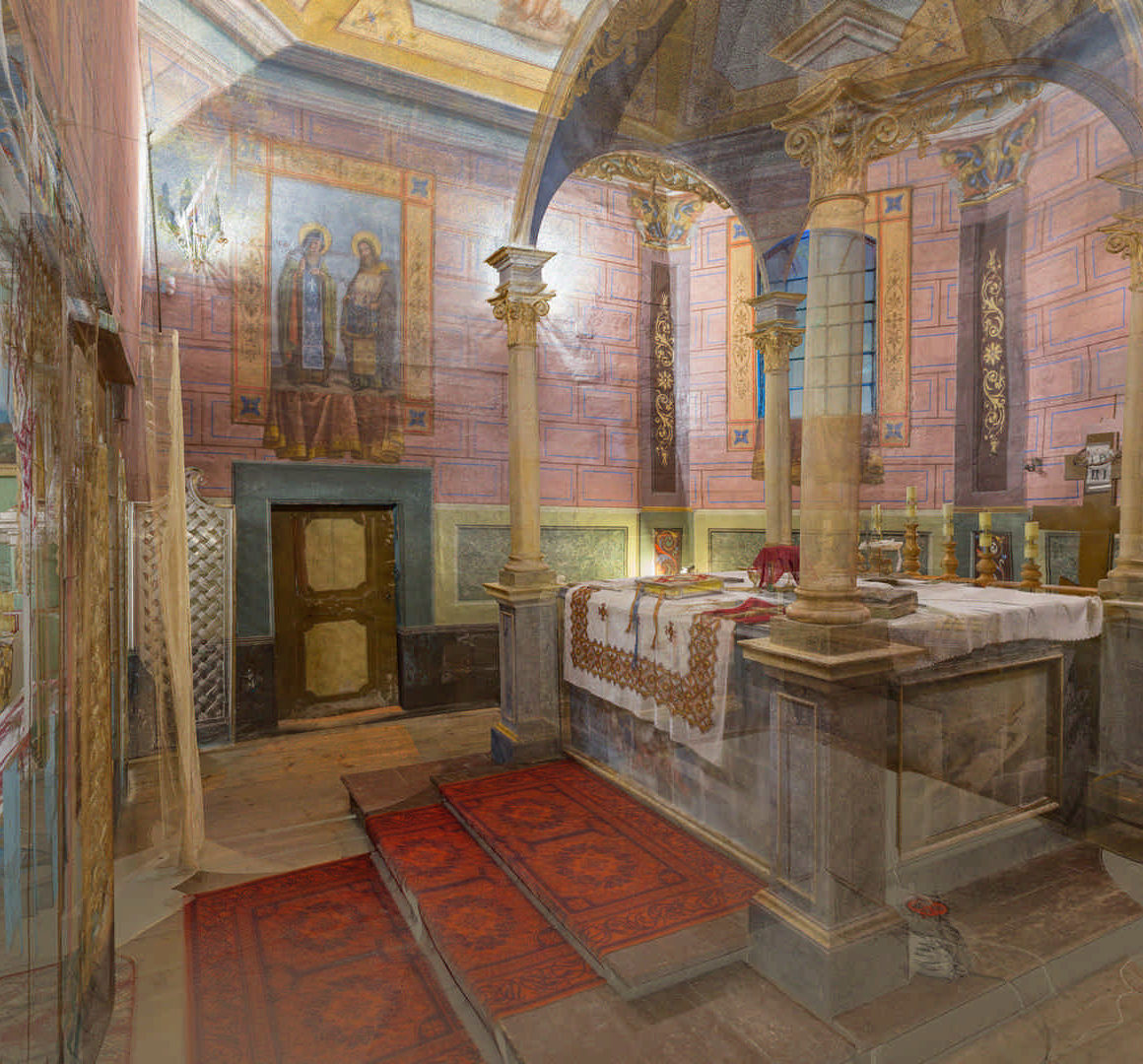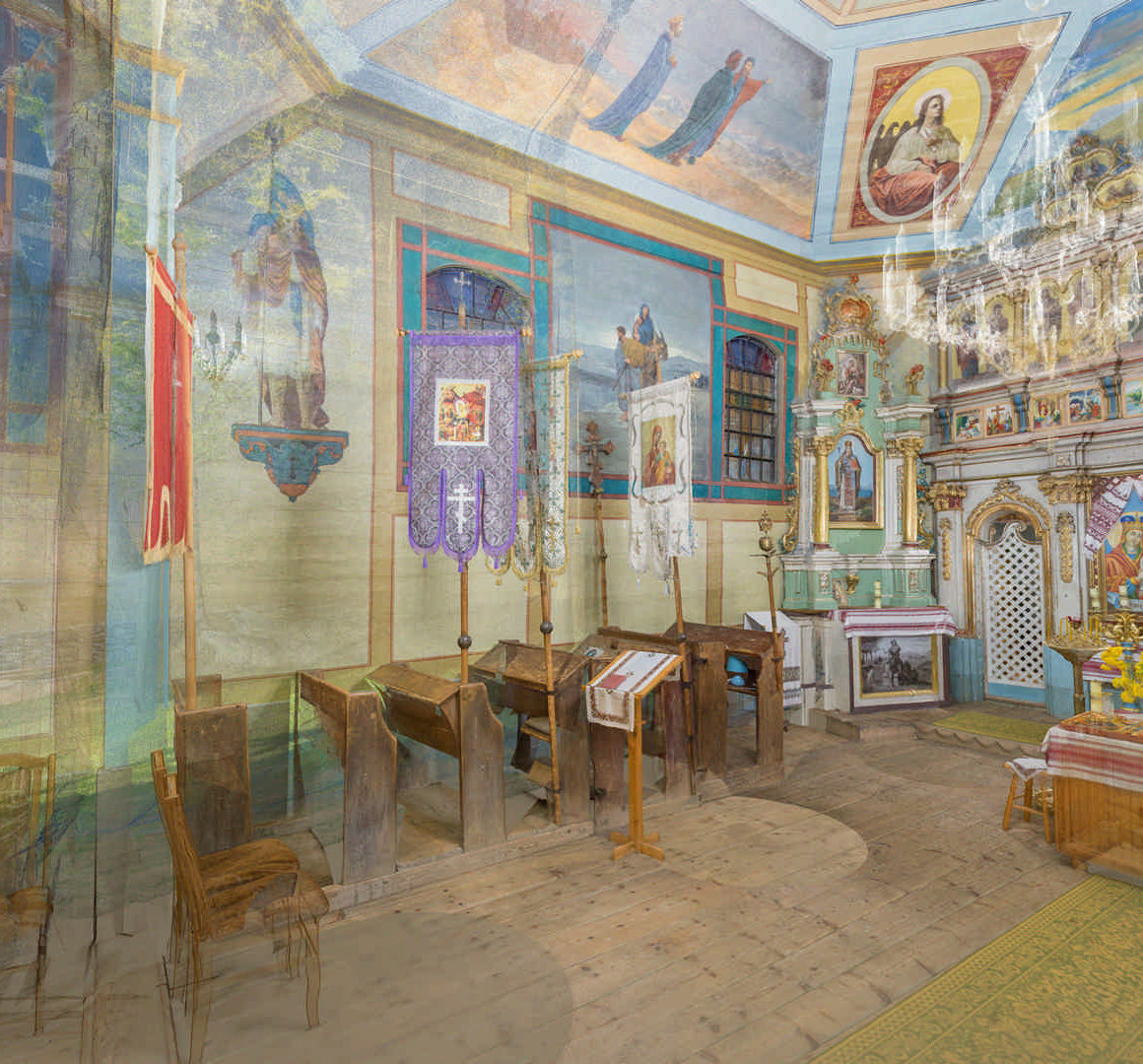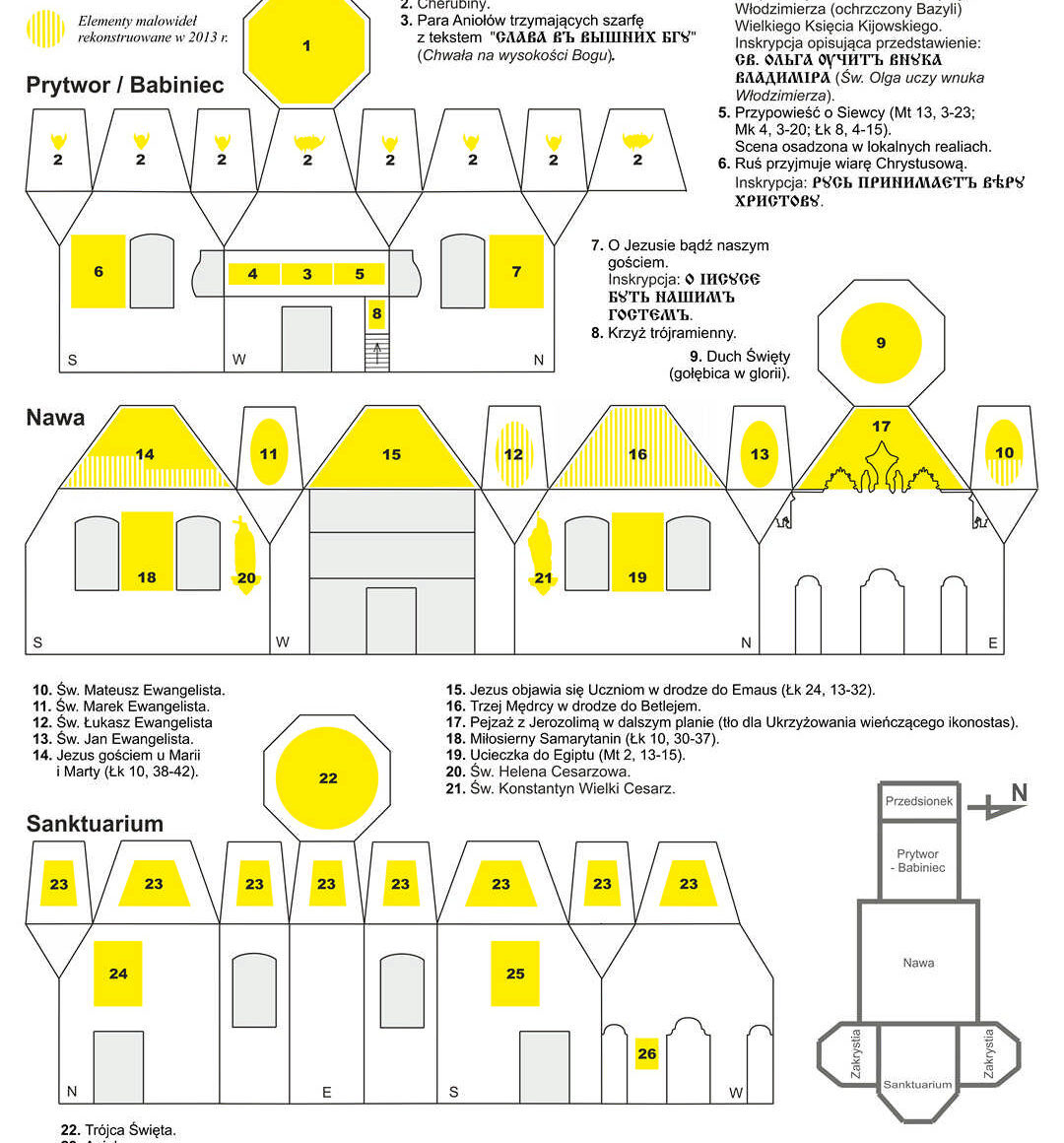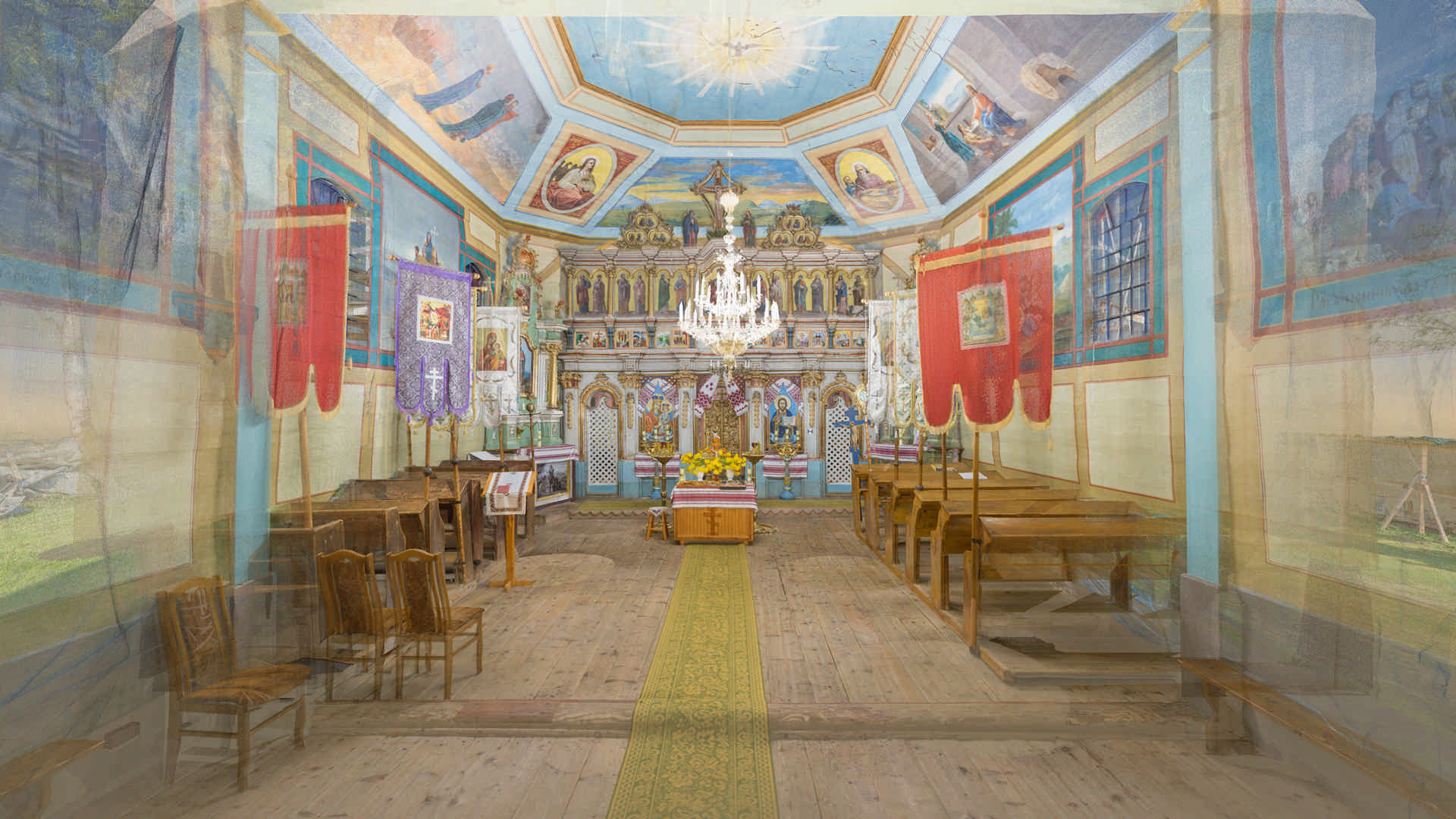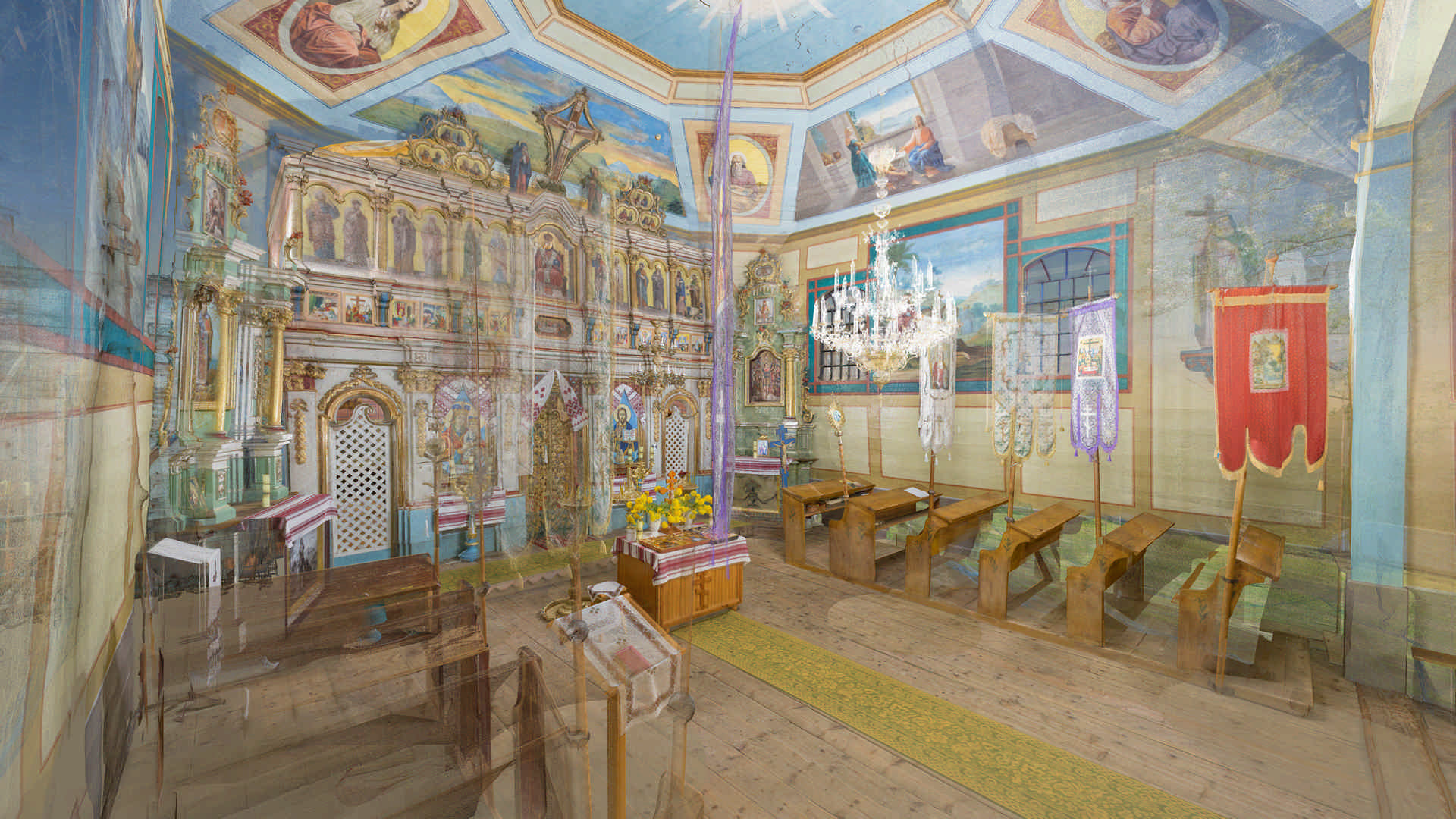Turzańsk – Orthodox church of St. Michael Archangel
The temple w as built at the beginning of the 19th century. In 1836, it gained a vestibule at the matroneum and a sacristy on the southern side. It is a log construction made of softwood.
It is a Lemko church. The temple consists of the following parts: matroneum, nave, sanctuary, and two sacristies. They adjoin the northern and southern sides of the sanctuary. The matroneum, nave, and sanctuary are covered by a joint metal roof. There is a narrow recess under the main roof where another, lower and narrower tier of the roof begins. Each of the five parts of the temple is topped with a bulbous turret. They are crowned with forged crosses each with two crossbeams. The lowest towers are located above the sacristy.
The matroneum and the nave are built on a square-like plan. The sanctuary is closed on three sides, which means that it is closed from the east with three walls: a straight one and two diagonal ones.
The walls of the church are boarded with vertical planks. The wood has taken on a brown shade.
The southern side of the temple has 5 windows and the northern side 5 They are rounded in their upper part.
In front of the entrance to the temple, there is a wooden bell tower from 1817. It is crowned with a bulbous turret covered with metal.
The first church in Turzańsk was mentioned as early as 1526. In 1947, as part of Operation Vistula, the Ukrainian population living in the village was deported. Until 1961, the temple was used by a Roman Catholic church. In 1963, it was returned to the Orthodox parish.
The length of the entire building: 22.5 m
The length of the matroneum: 5.5 m
The length of the vestibule: 2.7 m
The length of the nave: 8 m
The length of the sanctuary: approx. 6 m
The width of the matroneum: 6 m
The width of the nave: 8 m
The width of the sanctuary: approx. 6 m
The height of the tower above the matroneum: approx. 17 m
The height of the tower above the nave: 19 m
The height of the tower above the sanctuary: 16 m
The height of the towers above the sacristies: 10.4 m
Polychromes in the church in Turzańsk
Josyp Bukowczyk’s polychromes (wall paintings) cover the interior of the entire temple. They were created in 1898. The polychromes that contain elements of Lemko culture are the most noteworthy ones.
On the northern wall of the matroneum, i.e. to the left of the entrance, Bukowczyk made a painting with a signature in the Church Slavonic language: “Jesus, be our guest”. It has the shape of a rectangle (25 centimeters x 60 centimeters). It has a blue and red frame. It shows a room of a Lemko cottage. We can see Jesus with a peasant family: a woman, a man in his prime, an old man, and two girls. They are wearing clothes typical of the Lemkos of that time. The painting captures this scene in a very realistic way. The colors are dimmed, with shades of brown, white, and blue dominating the picture.
They are all standing around a round table and three chairs – the only pieces of furniture in the room. They are in the middle of the room. On the left, we can see Jesus coming to the table. His slim figure is much taller than the others. It is shown in semi-profile. Around his long brown hair, we can see a delicate halo. His gentle face is covered with a short brown beard. Jesus is wearing a long loose blue robe, with his subtle hands emerging from the wide sleeves. He is raising his right hand in a gesture of blessing. We can see his bare foot peeking out from the bottom edge of the robe.
To the left of Jesus, there is a man. He is standing in front of us, leaning towards the guest. He is inviting him to the table with his left hand. He has short brown hair. The man is dressed in a fair linen shirt and a brown jacket, the so-called hunia. He is also wearing nohawky, or pants made of white cloth. In his right hand, the man is clutching a black felt hat (uhersky).
We can also see a woman standing with her back to us, stopped in midturn. She is setting a bowl on the table. Her head is turned towards Jesus. She is wearing a white linen rańtuch, or headscarf covering her shoulders and back. The woman is also wearing a white blouse. Its wide sleeves have creases at the cuffs and at the height of the elbow. She also has a navy blue skirt flowing down to the middle of the calf – the Lemkos called it a kabat. It is heavily creased at the waist. Over the skirt, the woman is wearing a red apron, or zapaska. To the left of the woman, there is a chair.
In the background, we can see an old man standing. He is looking at Jesus, while bowing humbly. His hands are intertwined as if in prayer. His stooped silhouette is covered with a white shirt and trousers. The old man is also wearing a blue linen vest, the so-called łajbyk.
One of the little girls is standing sideways, between the woman and the old man. She reaches up to the adults’ waist. She has put her hands on the back of the chair. She is staring at Jesus. The girl has fair braided hair. She is wearing a white blouse, a red skirt, and a white apron.
The other girl is standing in front of us, between the man and the old man. She is also leaning on a chair and looking at Jesus. Her hair is covered with a white headscarf tied under her chin. She is wearing a white blouse. The skirt is covered by a white apron.
The walls of the cottage are made of simple logs. The ceiling is covered with boards. The wall straight in front of us has a rectangular window. The frames divide the glass into small squares. This made them easy to replace if they got broken.
The wall on the left has doors and a high threshold typical of a Lemko cottage. The house has earthen floors made of compressed clay.
The scene emanates simplicity. The poverty of the characters and the devotion of the hosts with which they are looking at the extraordinary guest are striking. The realism of the detail is permeated by the aura of spirituality.
illustrations
1. Composition scheme of the arrangement of wall paintings. Compiled by Jarosław Giemza.
2. Icon of St. Apostle Jude Thaddeus from the Deesis iconostasis series made after 1803, repainted by Josif Bukowczyk in 1898. Photographs in white light and X-rays. Primary painting layer visible in the rtg: image of St. Jude Thaddeus with the image of Christ in his right hand (reference to the Apocrypha about Mandylion and the role of the Apostle in handing it over to King Abgar). The painting from 1898 shows the Apostle Tadeusz leaning on a club (the tool of his passion). Photographs by Piotr Frączek.
Video:


